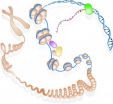CNIO participates in the ENCODE project: A stride forward in biomedical research
The information generated through this research project occupies 15 terabytes and required the equivalent of 300 years' computing time - It also marks the biggest collaborative effort ever mounted in the biology terrain
2012-09-06
(Press-News.org) The international Encode project, a collaborative study bringing together hundred of scientists from all round the world, including researchers working at the Spanish National Cancer Research Centre (CNIO), published results yesterday mapping the control and regulation of genome activity. These results indicate a total of four million 'switches' controlling the gene activity of 147 types of human cells and tissue. This map provides us with the first comprehensive vision of the genome as a complex web of interactions, and goes far beyond our initial thinking, which assigned it a linear structure.
CNIO participates in Encode through the Gencode project. Gencode (www.gencodegenes.org), coordinated by Tim Hubbard of the Wellcome Trust Sanger Institute in the United Kingdom, is made up in turn of seven groups, with three European representatives including Roderic Guigó's group at the CRG (Barcelona) and the CNIO group led by Alfonso Valencia. The CRG and CNIO groups involvement in the project is part funded by the Spanish Institute of Bioinformatics (www.inab.org) belonging to the Instituto de Salud Carlos III.
Gencode's mission is to create a reference geneset plotting the mass of information that comes out of Encode. We can say that Gencode supplies the system of references, annotations and coordinates needed to draw up the finished map. These references include the location, level of activity and type of genome-generated products, with regard to both protein-coding genes in their different forms of expression (transcripts) and alternatively expressed variants, and other regions coding for diverse types of RNA instead of proteins and pseudogenes.
The CNIO group, comprising Michael L. Tress, José Manuel Rodríguez, Iakes Ezkurdia as well as Alfonso Valencia, head of the CNIO's Structural Biology and Biocomputing Programme, is tasked with developing and applying the annotation methodology for alternative splice forms. The results of this effort are discussed in one of the papers published in Nature and in related publications in the journals Genome Research and Molecular Biology and Evolution. These findings have helped substantially alter the way we understand the process of translating genetic information into the functional units formed by proteins.
For the CNIO group, forming part of Encode has meant the opportunity to test and refine new methods to unravel the complex problem of gene expression regulation, as well as a magnificent occasion to access information which, we can say, has proved indispensable (and sufficient) to round off analysis of the genomic data produced within the CNIO.
SOME KEY FACTS ON THE ENCODE PROJECT
Encode is a consortium funded by the NIH and headed by the National Human Genome Research Institute (NHGRI) in the United States and the EMBL European Bioinformatics Institute (EMBL-EBI) in the United Kingdom. Encode has mobilised the efforts of 442 scientists working out of 32 laboratories in the United Kingdom, United States, Singapore, Japan, Switzerland and Spain.
This ambitious international scientific partnership follows on from a pilot project which analysed a first 1% of the human genome and laid the technical foundations for what would come later. The results of the Encode pilot, summarised on a Nature front cover in 2007, were hugely impactful and have already collected many thousands of citations.
Full information on the Encode findings appear this week in thirty papers, six in Nature and a further 24 in journals such as Genome Research, and will simultaneously be made available through numerous servers and public information systems.
These results are already the touchstone for any existing or future genome study, including personalised cancer genomic initiatives. Indeed, recent evidence has found a close relationship between alterations in the switches regulating genome activity and the appearance of cancers, underscoring the study's importance from a biomedical perspective.
A prime example of this connection are the mutations observed in genes involved in the processing of genomic information in patients with chronic lymphocytic leukaemia, as recently discovered by the Spanish consortium forming part of the International Cancer Genome Project (CLL-ICGC, Nature Genetics, 2011).
### END
ELSE PRESS RELEASES FROM THIS DATE:
2012-09-06
With the impending completion of redevelopment on 1 & 7 Ionia and another property closing in downtown Grand Rapids, Michigan, soon to be announced, urban real estate development firm 616 Development is establishing its brand in the digital space. The company's new website, 616Development.com, offers detailed insights into the company's founding, its core members, key development projects and its unique approach to urban development. Alongside engagement in prominent social networks, the website lays the foundation for the brand's voice in both digital and non-digital ...
2012-09-06
NEWPORT, Ore. – Magellanic penguins have a high level of variation in genes associated with the ability to fight infectious disease, but a recent study found that the mechanism the penguins use to ensure that diversity is far from black and white.
Found exclusively south of the equator in South America, Magellanic penguins assemble in large nesting colonies along the coasts of Argentina, Chile, and the Falkland Islands. They typically mate for life, producing clutches of two eggs that are cared for by both parents. While individual colonies can number in the millions ...
2012-09-06
MINNEAPOLIS – New research shows that professional football players may be at a higher risk of death from diseases that damage the cells in the brain, such as Alzheimer's disease and ALS (also known as Lou Gehrig's disease), compared to the general U.S. population. The study is published in the September 5, 2012, online issue of Neurology®, the medical journal of the American Academy of Neurology.
The study included 3,439 players with an average age of 57 from the National Football League with at least five playing seasons from 1959-1988. Researchers reviewed death ...
2012-09-06
The World Health Organization is about to roll out a new strategy for AIDS prevention in South Africa, a country where more than 5 million people are infected with HIV. Based on a mathematical model, the WHO predicts this strategy will completely eliminate HIV in South Africa within a decade.
But not so fast, suggests a group of UCLA researchers. Their work challenges the proposed strategy by showing it could lead to several million individuals developing drug-resistant strains of HIV. And further, they say, it will cost billions of dollars more than the WHO has estimated. ...
2012-09-06
Sleep disruptions may be among the earliest indicators of Alzheimer's disease, scientists at Washington University School of Medicine in St. Louis report Sept. 5 in Science Translational Medicine.
Working in a mouse model, the researchers found that when the first signs of Alzheimer's plaques appear in the brain, the normal sleep-wake cycle is significantly disrupted.
"If sleep abnormalities begin this early in the course of human Alzheimer's disease, those changes could provide us with an easily detectable sign of pathology," says senior author David M. Holtzman, MD, ...
2012-09-06
Population Council scientists have found that a vaginal ring releasing an anti-HIV drug can prevent the transmission of SHIV in macaques. This study provides the first efficacy data on the delivery of a microbicide from a vaginal ring, and indicates strong potential for the success of such rings in women. Microbicides are compounds that can be applied inside the vagina or rectum to protect against sexually transmitted infections (STIs), including HIV.
"This proof-of-concept study confirms that the investment in vaginal rings as a delivery system for HIV prevention is ...
2012-09-06
Researchers at the University of Washington have determined that the majority of genetic changes associated with more than 400 common diseases and clinical traits affect the genome's regulatory circuitry. These are the regions of DNA that contain instructions dictating when and where genes are switched on or off. Most of these changes affect circuits that are active during early human development, when body tissues are most vulnerable.
By creating extensive blueprints of the control circuitry, the research also exposed previously hidden connections between different ...
2012-09-06
The hundreds of researchers working on the ENCODE project have revealed that much of what has been called 'junk DNA' in the human genome is actually a massive control panel with millions of switches regulating the activity of our genes. Without these switches, genes would not work – and mutations in these regions might lead to human disease. The new information delivered by ENCODE is so comprehensive and complex that it has given rise to a new publishing model in which electronic documents and datasets are interconnected.
Just as the Human Genome Project revolutionised ...
2012-09-06
Albatrosses leverage the energy of the wind to fly with essentially no mechanical cost to themselves, very rarely flapping their wings, and new work published Sep. 5 in the open access journal PLOS ONE offers insight into how exactly they accomplish this feat.
The researchers, led by Gottfried Sachs of the Technische Universitaet Muenchen and Francesco Bonadonna of the French National Centre for Scientific Research (CNRS), used advanced GPS tracking to determine that the energy gain during the albatross's "dynamic soaring" comes from a repeated oscillation consisting ...
2012-09-06
Closer sleeping proximity between fathers and children is associated with a greater decrease in the father's testosterone level, with possible implications for parenting behavior. The full report is published Sep. 5 in the open access journal PLOS ONE.
Fathers' testosterone levels have been associated with parenting behavior and involvement across species, with higher levels generally associated with lower parental involvement. The authors of the current study, led by Lee Gettler of the University of Notre Dame, studied 362 fathers in the Philippines to determine whether ...
LAST 30 PRESS RELEASES:
[Press-News.org] CNIO participates in the ENCODE project: A stride forward in biomedical research
The information generated through this research project occupies 15 terabytes and required the equivalent of 300 years' computing time - It also marks the biggest collaborative effort ever mounted in the biology terrain


